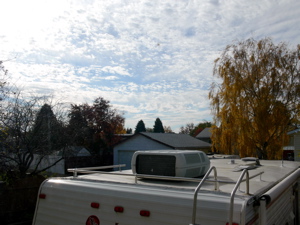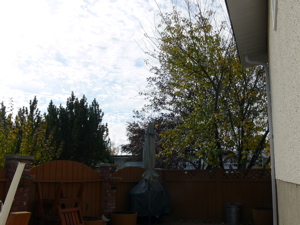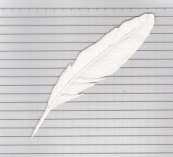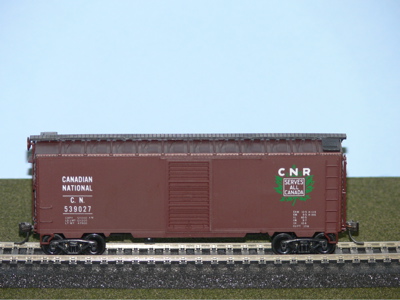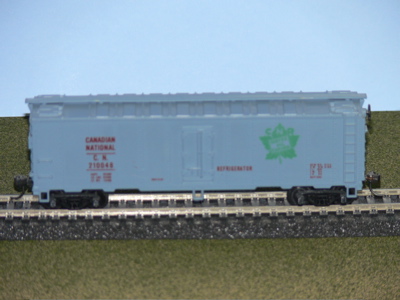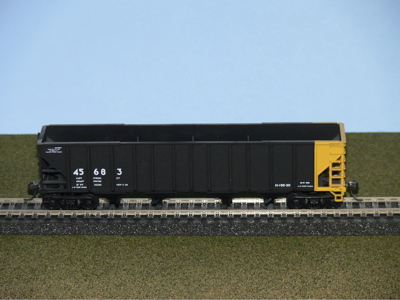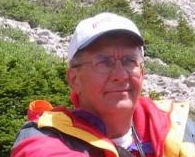 |
|
||||||||||||||
| Links to Notebook Pages: |
Thursday October 19, 2006 5:30 am Lethbridge Sunrise 7:59 Sunset 18:34 Hours of daylight: 10:35
A. Morning Musings
5:30 am It is +4 C at the moment. The forecast is for a high of + 14 C.
My weight is down 1 to 183. I was stuck at 184 for almost a week. It is nice to see the graph dip again.
This morning is refreshing. I have nothing on my plate for the day. It feels like this is the first such day since I retired. The "big three" Learning activities (model trains, mathematics, literature) will all receive some attention. Now to spend a few minutes drinking coffee and thinking about potential activities.
Model Trains: I should have no difficulty adding two more terminal tracks to the outer mainline loop, thus completing the power wiring for that section of the layout. I will also try to get the reversing loop working so I can run trains from Coaldale to Black Diamond and back. I might thumb tack down the yard track at Black Diamond so I can begin some serious realistic running scenarios between Black Diamond and Coaldale. This would add incentive to build the coaling tower kit for Coaldale so I have a realistic destination for the coal. But the wiring comes first.
Mathematics: A quick review of groups and fields is in order. I want to complete making my notes for chapter 4 of "Fearless Symmetry" and have a brief look at another book on groups, "Group Theory and Chemistry" by David Bishop.
Literature: I plan to spend a couple of hours with this, rather than the one hour that has been more common recently.
B. Plan
Immediate Health Walk & exercise 1 hr Model Trains Complete wiring outer mainline; mtce 4 cars, add to layout 2 hr Mathematics Read & make notes for "Fearless Symmetry" chap 4 1 hr Literature Begin reading "Standing Stones" by John Metcalf 1 hr Later Chores Investigate water softeners for home Technology Read manual for cell phone Make notes for chap. 4 of "Switching to the Mac" Begin reading "iPhoto" digital photography - learn about using the various manual settings
Literature Read "The Art of Living" by Epictetus Read "The Song of Roland" Mathematics Larson "Calculus" Read "The Computational Beauty of Nature" Chap 3 Gardner "The Colossal Book of Short Puzzles" History Continue reading "Citizens" Watson "Ideas" Model Trains Build oil refinery diorama: add ground cover Assemble second oil platform kit Puzzles The Orange Puzzle Cube: puzzle #9
C. Actual/Notes
6:40 am
The first step for each session should be a review of the previous session's notes.
The two major ideas so far are those of a group and those of a field.
A group is a set of elements and a binary operation (often called a composition) that describes how to obtain an element given two other elements. The set is closed under this operation (i.e. given any two elements in the set and the operation, one always obtains another element in the set). There is an identity element (usually represented by the letter e) such that for any element in the group, xe = ex = x. Every element has an inverse (i.e. xy = yx = e). Finally, the associative law holds for the operation (i.e. for any three elements, (xy)z = x(yz) ).
A field is a special type of group that has a second binary operation (the two operations are usually called addition and multiplication) where element has a multiplicative inverse. One example of a field is the set of integers 0, 1, 2, ... (p - 1) where p is a prime integer and the two operations of addition and multiplication modulo p
I want to play with this a bit by creating the addition and multiplication tables for
,
,
and
. Of particular interest are the tables for
as the generator for this set is not a prime number.
+
*
+
*
+
*
Multiplication falls apart in the case where the modulus is a composite number. The last table does not satisfy the criteria for a field.
Fearless Symmetry Chapter 4 Modular Arithmetic [p. 31 - 41]
- "... modular arithmetic ... is our way of dealing with dvisibility of numbers and remainders." [p. 39]
- "... modular arithmetic gives us not one but two groups for each prime p." [p. 39]
- "
is a group under addition. The neutral element is 0. The inverse of any number a (mod p) is just p - a (mod p)." [p. 39]
- "If we throw 0 away from
, we get a new set, with only p - 1 elements, called
, pronounced 'eff-pea-cross'. It is a group under multiplication." [p. 39]
- "We can use congruences to prove that some equations have no integral solutions." [p. 41]
Example: There are no integers x and y with the property
.
Suppose there were two such integers, x and y.
Since
, then
since if
, then
modulo any number we like.
Consider the squares: they are 0, 1, 4, 9, 16, 25, 36, 49, ... . Modulo 4 they are 0, 1, 0, 1, 0, 1, 0, 1, ... So
is either 0 or 1 modulo 4. The same is true for
. Therefore their sum must be either 0, 1, or 2. Now consider 11. It is 3 (mod 4). Therefore it cannot be the sum of two squares.
This is so neat!
Using MathType within OS X is working quite well for the mathematical notation.
Now to move away from the screen and read chapter 5 Complex Numbers.
3:00 PM I have added 2 more barrier strips and have now completed the power wiring for the outer mainline track. I am now thinking of adding an Atlas Twin controller so I can control the reversing loop for the outer mainline track.
I also took 4 more rolling stock out of a box, dusted them off, checked the coupler action and height, and then let locomotive diesel CN 7847 pick up each of these cars from a siding in the Coaldale yard and move them to a classification track. I now have 1 diesel locomotive and 13 rolling stock on the layout.
The two hopper cars are from the modern era whereas the box car and refrigerator car are from the mid 1900's.
D. Reflection
